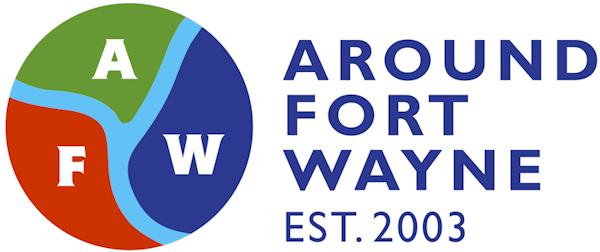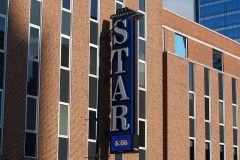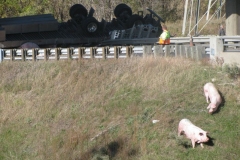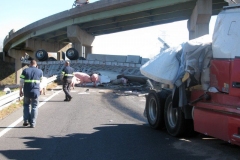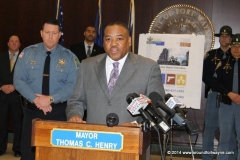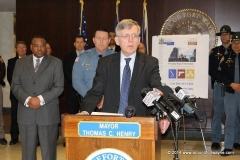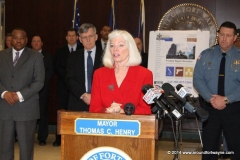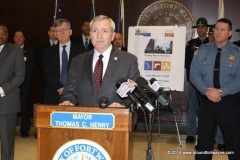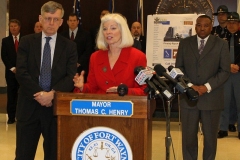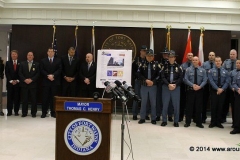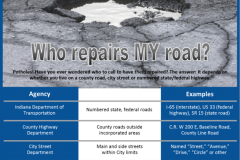
Text of Indiana Governor Eric J. Holcomb’s address to Hoosiers, ‘The Road Ahead,’ regarding where the state has been and where it is going in the months ahead with the COIVD-19 pandemic.
Download the text provided by the Governor’s office.
Fellow Hoosiers.
A year ago to this day, I stood in this office and discussed the unprecedented challenge before us.
We didn’t know much about COVID-19 back then, and to be sure, we weren’t alone.
From Asia to Europe to Indiana, the world was beginning to experience sickness and death, the likes we’d never seen in over a hundred years.
Today:
- Globally, there have been more than 2.6 million COVID-19 related, premature deaths.
- 550,000 of them in the United States. It’s been the cause of the greatest single year of loss of life in America ever.
- In fact, in early February, COVID became the leading cause of “daily deaths” in the United States, surpassing heart disease and cancer.
- And, back home in Indiana, we Hoosiers learned of our first known COVID death, Roberta Shelton, of Indianapolis, on March 16th.
- One year later, more than 12,500 Hoosiers are forever absent from their family photos, family reunions and workplaces.
Yes, with this novel virus came the realization that we lacked many of the basic tools we needed to combat it, early on.
PPE – personal protective equipment – became a household term, as did swabs.
Just obtaining swabs became a full-time job, much less finding the other materials needed to expand our COVID testing protocol, on a broad scale and easy for all to access.
Remember, in the beginning, we were using but one testing site, our State Health Lab, because that’s what we needed pre-COVID.
And because we didn’t know just exactly how the virus spread, handwashing and keeping your distance became the standard practice to slow the transmission of this uber-infectious airborne virus.
And, of course, even the very idea of a vaccine, was only beginning to be researched and developed in labs across the world.
By mid to late March last year, our daily positive case reports were reaching 20 percent of tests, and our seven-day average positive case rate was increasing steadily.
Deaths caused by this single virus began to rise rapidly, especially among our seniors.
So, it was on this very day a year ago, I announced that a good many of us needed to hunker down to break the chain and flatten the curve, allowing us to gain our footing to care for the massive onslaught of those in urgent need of care.
That 6-week period last spring also allowed us as a state to balance the sanctity of life with the necessity of our livelihoods.
We plainly said public health policy and the common good must go hand in hand with personal responsibility, not either-or.
We also said, just like the teamwork displayed on the hard wood courts now during March Madness, teamwork at the state, local and federal governmental levels would be critical, giving us the ability to act quickly, in unison, to make decisions in the moment, even if they weren’t unanimously accepted or popular.
Let me tell you, even as humbled as I am by our loss, I’ve never been prouder.
Prouder, because of the Hoosier Spirit.
Indiana, indeed, rose to the challenge, time and time again.
Lilly set up a testing site that enabled us to grow from a few hundred COVID tests a day to thousands.
Indiana Face Mask in Rensselaer started a new line to make CDC-approved N95s.
Roche distributed COVID testing equipment.
The GM plant in Kokomo kicked into high gear to manufacture ventilators.
Anonymous donors came forward with PPE.
Amazingly, many of our homegrown innovative Indiana companies turned on a dime and changed their business lines to make masks, gowns, face shields and sanitizer on a scale never seen before.
Seemingly overnight, Zotec created a system to schedule COVID test appointments user-friendly and simple, a system that continues to serve us well with the country’s most efficient vaccination scheduling system.
And on the top of my thank you list, it’s been our hospitals and health care workers who’ve taken on the brunt of this daily deadly disease.
They scrambled to protect their own staffs, doctors, nurses, assistants, cleaning crews, volunteers, retired medical workers and the like.
They worked nonstop, shift after extra shift, to keep up on the deluge of patients, many needing critical care.
They were as overwhelmed and exhausted as their patients, who left loved ones behind at the emergency room door because the stakes were too high to let visitors in the room.
There’s never been a day that goes by that I don’t think about the thousands of Hoosiers who have passed away, many of them scared and alone, and for their loved ones who couldn’t lay them to rest in the manner of their choosing and are still coping to come to terms with such a sudden loss.
In a way, the hero in this modern-day tragedy is everyone who adjusted their lives to protect our families, our coworkers, our neighbors or even just someone walking down a store aisle.
Retail store employees masked up and stood behind plexiglass to keep our shelves stocked.
First responders transported, cared for, and became links between separated loved ones.
Parents became teachers, and teachers became virtual links to learning.
Nursing home employees cared for elderly residents most at risk.
Zoom became our way of work, our way of meeting, and working remote became a new way of life.
Neighbors looked in on neighbors, brought them groceries and medicine and sometimes just talked with them, safely distanced or through a window.
Our own team, led by:
- Doctors Box and Weaver,
- Our State Health Lab and all the hundreds of Department of Health staff who have not slept since sometime in early 2020, as well as Doctors Sullivan, Rusyniak, Kaufman, Dauss,
- the Department of Homeland Security,
- the men and women serving in the Indiana National Guard,
- the Department of Correction,
- the IEDC, Indiana State Police, INDOT, the BMV, your entire state government has come together as a family and managed our response, driven by the data, since day one.
And, throughout this unimaginable year, we as a state, have come a long way back together.
Going back to that earliest possible point, May 4th to be exact, we began to reopen what had temporarily been closed, and by early summer commercial businesses, restaurants, and our cultural and entertainment venues were operating in at least some capacity.
Along the way, we gained a new appreciation for the great outdoors and we began to work on going back to work and school safely.
Then, again, the fall and winter brought a second surge – even worse community spread, cases, hospitalizations and deaths – and we had to double down on keeping gatherings to a minimum during some of our most important holidays.
But our businesses remained open when other states shut down.
We showed we could balance, and we showed we would persevere.
And today, we’re in a different and better place.
While Indiana’s steady unemployment rate was 3.1% pre-COVID, it spiked to 16.9% almost overnight last spring.
Today, it stands back at 4.2%, one of the lowest in the country, and lower than every state we touch.
After our restaurant and hospitality industry was walloped, it too is rebounding while many other industries in Indiana have actually grown – reflected in our above forecasted state revenues.
To be sure – and back to the “teamwork theme” – the federal financial aid we’ve received has helped many of those sectors along the way, including individual Hoosiers with direct assistance and enhanced unemployment insurance, small business assistance with the Paycheck Protection Program, and direct financial support going to hospitals, schools and municipalities.
All told, more than $37 billion are expected to reach Hoosiers!
At the same time of such loss, Indiana attracted over 31,000 new job commitments in 2020, an all-time record, because they too believe in Indiana and how we do business, today, and well into the future.
Companies like Catalent and Eli Lilly are filling vaccine doses and developing new drugs that can significantly help reduce hospitalizations and deaths among highrisk patients who contract the virus – and those who are keeping our PPE supply replenished and fresh – have made the difference in meeting the immediate needs of the day.
Add the fact that our medical providers now know more about how to treat patients and we the people all know how the virus is transmitted and how our personal actions can slow it.
Which is why and what brings me to you today:
- Our current cases, positivity rate, hospitalizations and deaths have all dropped drastically since mid-January, and three vaccines have been approved and put to use.
- While more than 675,000 Hoosiers have tested positive for COVID-19, we also know that not all positive cases are identified through testing, as our own scientific study led by researchers at the Richard M. Fairbanks School of Public Health at IUPUI confirmed. So, the total number of Hoosiers who have been positive for COVID is estimated to be 2.5 times the number our positive lab tests show.
- Our hospital census reached nearly 3,500 COVID patients in early December, but today stands at 600 people. Daily COVID admissions have averaged about 60 people for the past two weeks.
- Last fall, 44% of our ICU beds were in use for COVID patients. Now, it’s 4.6%.
- Last spring, we completed only a few hundred COVID tests a day. Today, we can do 50,000+ if needed.
And what’s been the real, life and death game-changer, has been access to vaccines.
Our approach to vaccinating Hoosiers has been simple: vaccinate those who are most at-risk for hospitalization and death first, which meant our seniors and all those medically at-risk were first in line.
Thankfully, we’ve had hundreds of partners on the ground helping us and hundreds more who are ready to open their doors when needed.
And through it all, our system to schedule and complete first and second round vaccinations, has operated as smoothly as any in the country.
Today, more than 970,000 Hoosiers are fully vaccinated, 17.8% of Hoosiers 16 and older.
27% have had at least their first dose.
Yesterday, we opened vaccinations to those 40 and up. In the first 24 hours, more than 40,000 registered.
Now, if you’re watching from home and only concerned about the road ahead, here’s where you might want to turn up the volume.
Our current state public health emergency and COVID Executive Order, expire on March 31st.
I will renew the public health emergency for another 30 days because it allows us to take action quickly if conditions take a turn for the worse, and allows us to continue to access the hundreds of millions of dollars in federal funds that are helping the hardest hit Hoosiers weather this lingering storm.
The current COVID restrictions will be extended as is through April 5, because of all the out of state visitors we have in Indiana right now and most importantly, to continue to give Hoosiers with comorbidities the opportunity to schedule or get vaccinated.
Earlier today, our federal partners told states to expect large increases in the amount of vaccine that will be flowing to us, beginning the last week in March. So on Wednesday, March 31, we’ll plan to open up vaccine eligibility to all Hoosiers – 16 years and older – anticipating we’ll receive additional doses of all three vaccines.
Already, we have nearly 500 sites available throughout the state that are inoculating Hoosiers, and we’ll expand our reach by implementing a large employer vaccination program that has been in the planning stages for weeks now, to provide an even more convenient way to get vaccinated.
We’ll schedule additional mass vaccination clinics in April, just like we hosted in Gary, Sellersburg, Indy and this upcoming weekend in South Bend.
We’ll continue sending our mobile units to targeted areas throughout the state to assure that our distribution is fair and equitable, in all corners.
Also, starting on April 6:
- All decisions about venue capacity will be in the hands of local officials. The state department of health will continue to provide county metrics each week, color coded, which are key to knowing whether virus levels are increasing or decreasing locally, but the metrics will be guidelines for local consideration regarding size limits of each social gathering.
- Customers in restaurants, bars and nightclubs will no longer be required to be seated. Six feet of spacing between tables and other seating will still be recommended, as is spacing between non-household parties.
- Social distancing is still recommended.
- All businesses should maintain a COVID response plan that provides COVID safeguards.
- Hospitals may return to a normal state when scheduling non-emergency procedures and surgeries.
- Our best data is that close to 90% of all schools are operating in-person and many of the remainder have hybrid schedules. Please know our Departments of Education and Health will work together to update health guidance in preparation for the next school year.
- Thankfully, all our teachers have the opportunity to be vaccinated and our schools are receiving hundreds of millions of dollars for COVID expenses. So it’s my hope and expectation that our K-12 schools will provide full-time, in-person instruction for the 2021-2022 academic year using what they’ve learned and with the additional local, state and federal resources provided.
Also, on April 6, the face covering mandate will become a state mask advisory, although face coverings will remain mandatory in all state buildings and facilities and in all vaccination and COVID testing sites until further notice. K-12 schools will continue under current face covering requirements through the remainder of the 2020-21 school year.
As always, local governments, businesses and other entities may impose more stringent guidelines, such as choosing to keep mask wearing mandatory in their facilities. So whether that is a bank branch lobby, on the factory floor, or a county courthouse or city hall, they retain the authority to make decisions about COVID restrictions for their operations and should be afforded the respect, compliance and
understanding of all who visit them.When I visit my favorite restaurant or conduct a public event, I will continue to appropriately wear a mask. It is the right thing to do. Hoosiers who take these recommended precautions will help us get to what I hope is the tail end of this pandemic.
Until then, please remember.
If you test positive, isolate.
If you are a close contact of someone who is COVID positive, follow CDC guidelines and quarantine.
If you’re sick or symptomatic, don’t go to work or any place else for that matter, free COVID tests are available throughout the state, so get tested.
Wash your hands frequently, and please, be cautious about contact with seniors and those with high-risk medical conditions.
Ladies and gentlemen, as we continue to do these few things, the light at the end of the tunnel, becomes brighter and brighter.
Buying tickets for March Madness games, planning for all our local fairs and festivals, or the greatest spectacle in racing itself tells me that all those life delights I once took for granted are coming back online.
It’s up to each and every one of us to do our part to stay on our course.
Thank you and have a good night.
COVID-19 World Wide Web Resources
Allen County Department of Health COVID-19 Guidance and Local Resources
State of Indiana Web Resources:
- Indiana’s Mortgage Assistance Program
- List of who is eligible to receive the COVID-19 vaccine
- Eligible? Click here to register and make an appointment
- Indiana State Department of Health’s COVID-19 information and stats
Other Web Resources:
- Centers for Disease Control and Prevention’s COVID-19 webpage
- Centers for Disease Control and Prevention’s COVID-19 cases in the United States
- John Hopkins’ COVID-19 Dashboard
- Latest news from Google News
